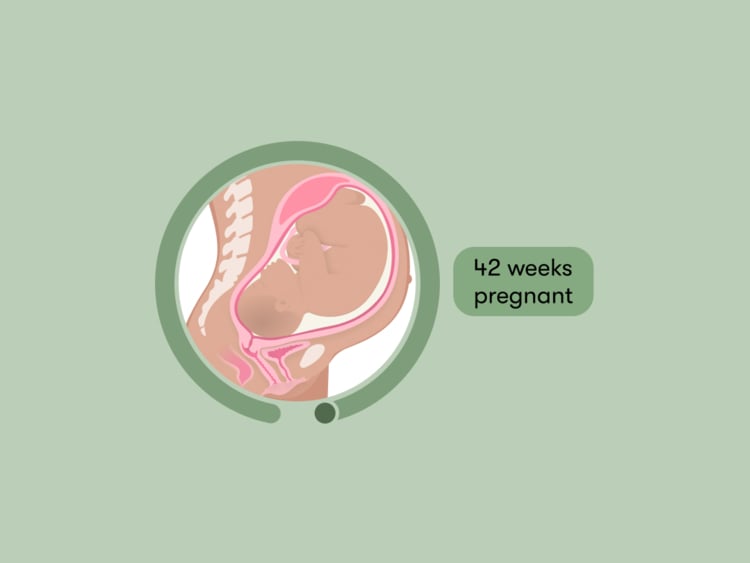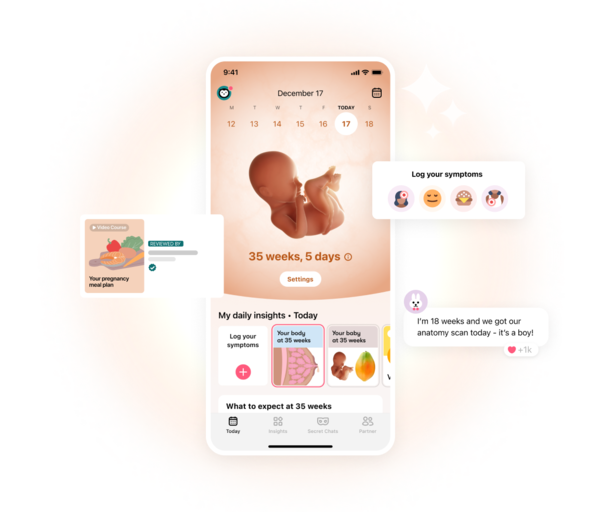From looking out for signs of labor to being induced, here’s the lowdown on being 42 weeks pregnant.
-
Tracking cycle
-
Getting pregnant
-
Pregnancy
-
Help Center
-
Flo for Partners
-
Anonymous Mode
-
Flo app reviews
-
Flo Premium New
-
Secret Chats New
-
Symptom Checker New
-
Your cycle
-
Health 360°
-
Getting pregnant
-
Pregnancy
-
Being a mom
-
LGBTQ+
-
Quizzes
-
Ovulation calculator
-
hCG calculator
-
Pregnancy test calculator
-
Menstrual cycle calculator
-
Period calculator
-
Implantation calculator
-
Pregnancy weeks to months calculator
-
Pregnancy due date calculator
-
IVF and FET due date calculator
-
Due date calculator by ultrasound
-
Medical Affairs
-
Science & Research
-
Pass It On Project New
-
Privacy Portal
-
Press Center
-
Flo Accuracy
-
Careers
-
Contact Us
42 weeks pregnant: Your guide to this week of your third trimester


Every piece of content at Flo Health adheres to the highest editorial standards for language, style, and medical accuracy. To learn what we do to deliver the best health and lifestyle insights to you, check out our content review principles.
Throughout your pregnancy, people may have liked to guess if your baby was going to come by your due date or keep you waiting for a little longer. While you might have had your due date circled in your calendar for months now, Dr. Allison K. Rodgers, reproductive endocrinologist, obstetrician, and gynecologist at Fertility Centers of Illinois, US, suggests looking at the last days and weeks of pregnancy as more of a due month rather than a specific date. At 42 weeks, you may be around two weeks past your due date and are officially considered to be postterm.
While it isn’t uncommon to give birth after your due date, many health care providers don’t suggest carrying beyond 41 or 42 weeks. You’ll likely have spoken to your doctor about induction. But what does this mean? From looking for signs of labor and delivery to the different methods of induction, here’s the lowdown on being 42 weeks pregnant.
Your baby at 42 weeks pregnant
Your baby is ready to be born
At 42 weeks, you’ll likely feel very ready for your baby to arrive, and your baby is ready to be born. Throughout your third trimester, your baby’s organs and systems have developed and matured, and they’ve been gaining weight. However, by 42 weeks, the rate at which they grow slows a little.
You might remember that while in the uterus, your baby is covered by the vernix caseosa (a creamy protective layer) and lanugo (tiny, downy hairs). They protect your baby’s skin from the amniotic fluid. Most babies will lose both the vernix caseosa and lanugo either partially or fully by the time that they’re born, and some babies who are postterm lose it early, meaning they can be born with red, dryer skin. This isn’t something to be too worried about. They will naturally lose this top layer of skin in the few days after they’re born, and the skin underneath will be soft.
How big is a baby at 42 weeks?
Length (crown to heel): 52 cm or 20.5 in
Weight: 3.8 kg or 8.3 lb
Size: Equivalent to a watermelon
All measurements are approximate and vary within the normal range.

Your body at 42 weeks pregnant
You may be induced
Your health care provider may have offered for you to be induced if you haven’t naturally gone into labor by 42 weeks. Induced simply means that your doctor will either use medicine or another method to help kick-start labor. You might have learned about this and the different methods of labor in your prenatal classes but not be totally sure how it happens.
There are different methods of inducing labor, and your doctor will likely examine you before you’re induced to determine what would suit you most. Some options include:
- Oxytocin injection drip: You might have heard of oxytocin being described as the love hormone before. This is because our body often produces it when you’re around people you love, building intimacy and connection. However, it also plays a crucial role in birth. Oxytocin can trigger uterine contractions and can also increase the production of prostaglandins, which aid with contractions. Your doctor may offer you an oxytocin injection drip to induce labor or to help you if your contractions slow down.
- Softening your cervix: During vaginal birth, your cervix dilates to around 10 cm to allow your baby to pass through. Pretty amazing, right? One way that your health care provider may induce labor is by softening your cervix to aid with dilation. They do this either by administering medicine called prostaglandins into your vagina or mouth or inserting a catheter with a balloon on the end into your cervix. The balloon expands, encouraging dilation.
- A membrane sweep: You might have heard your doctor talk about a “sweep” or membrane sweep as a way to encourage labor. If your cervix has started to dilate, your health care provider may insert a gloved finger into your cervix and swipe between your uterus and the amniotic sac. This can start the production of prostaglandins and may cause contractions.
Monitor changes in your body for signs of labor
At 42 weeks pregnant, you’ll likely have been on the lookout for some of the key signs of labor for a week or two now.
Flo’s pregnancy tracker can help you know what you might expect week by week. It can also help you feel more prepared for delivery with useful insights created by experts.
At this point in your pregnancy, you’ll also be seeing your health care provider as often as once a week — or even twice weekly. They’ll monitor both you and your baby, and look out for the signs that you’re ready to deliver naturally or be induced. Here’s what they’ll be looking for:
- Feeling your baby has dropped lower in your uterus. Your baby may do this as you get closer to labor.
- Increased vaginal discharge: This could indicate that your mucus plug is coming out.
- Your water breaking: Your water breaking may feel like quite a bit of splash or a small trickle. This is when the sack that your baby has been growing in (which is filled with amniotic fluid) breaks. If you think your water has broken, don’t hesitate to reach out to your health care provider.
- Contractions: This can feel like tightening around your bump and pain in your pelvis and back. Labor contractions come at regular intervals and get closer and more intense over time.
- Your cervix starts to dilate (Your doctor will have to check this.)
If you experience any of the above, you should reach out to your doctor immediately. They may want to call you in to examine you and confirm that you’ve gone into labor.
Your questions answered
Is being 42 weeks pregnant common?
No two pregnancies are the same, so it can be really hard to predict when you’ll give birth. However, if you’ve passed your due date, try not to worry. Only around 5% of babies are born on their given due date, and statistics collected on births in the United States in 2017 found that 0.33% of babies were born in week 42.
What causes a baby to be overdue?
There are a few different reasons why your baby may be overdue. Some of them include:
- Your due date was calculated incorrectly. This might have happened if you weren’t sure when your last period was due or if your cycles were irregular. If your due date wasn’t calculated correctly, then you may think you’re one or two weeks more pregnant than you are.
- You’ve been overdue before.
- You’re overweight.
- This is the first time you’re having a baby.
Are overdue babies bigger?
While it’s impossible to say that your baby will be big because you’re overdue, one of the risks associated with late and postterm pregnancies is that your baby will be bigger because they’ve been in the uterus longer and continue to grow while they’re in there.
Does the risk of stillbirth increase after 40 weeks?
There are some health risks associated with late-term and postterm pregnancy, including an increased risk of stillbirth, but it’s crucial to remember that these problems only occur in a very small number of cases. If you have any questions or concerns about your pregnancy, don’t be afraid to lean on your health care provider for support. There’s no such thing as a silly question, and it’s crucial that you feel as in control as possible as you approach labor. Your doctor will likely be closely monitoring both your health and your baby’s and will be able to offer you the best advice.
Is it safe to be 43 weeks pregnant?
As mentioned above, many health care providers don’t suggest carrying beyond 41 or 42 weeks. This is because there are some risks associated with late-term and postterm pregnancy. Many people who carry beyond their due date to 42 weeks will go on to have straightforward, healthy births. However, some risks include:
- Your baby being larger. As your baby is in your uterus for longer, they continue to grow. This could mean you need more assistance during birth and could cause tears during birth between the vagina and perineum.
- Too little amniotic fluid around your baby
- A decrease in blood flow to your baby
- Stillbirth or complications during birth
You will likely have already been in touch with your health care provider, but if you’re curious as to why you haven’t gone into labor yet or are anxious as to when it will happen, don’t be afraid to ask and lean on them for support.
Take a quiz
Find out what you can do with our Health Assistant
42 weeks pregnant checklist
Get ready for your baby’s arrival
Being 42 weeks pregnant can feel a little bit like a waiting game. You’ve finalized your birth plan and packed your hospital bag. You’ll likely have had many conversations about your baby’s name and may have a labor playlist prepared. You’re ready to go.
While it might not feel like the most practical way to prepare for your baby’s arrival, remember to get as much rest and relaxation as possible. Whether it’s watching your favorite series, journaling, or napping — do whatever makes you feel best. You’ll thank yourself during the first few weeks of sleepless nights.
If you need moral support now your due date has come and gone, you can chat to other women who are overdue using Flo’s Secret Chats.
Read up about different types of labor
Alongside learning the signs of labor, it can also be really helpful to read up about the different types of labor. Your health care provider may have encouraged you to create a birth plan. This can be looked at as an ideal roadmap for how you’d like birth to go. However, birth plans aren’t set in stone. You can change your mind at any point. Similarly, you may experience some medical complications during labor, which may mean your doctor may speak to you about alternatives for the safety of you and your baby.
Even if you don’t plan on having a cesarean section, epidural, or complications during labor, if an assisted birth (using forceps or ventouse, for example) is necessary, it can be really helpful to understand what they are in case your health care provider suggests they may be a good option for you.
When to consult a doctor at 42 weeks pregnant
Since you could have your baby at any time, it’s crucial to know and watch out for signs that you’re going into labor. These include:
- Your water breaking
- Having regular contractions
- Losing your mucus plug
At 42 weeks pregnant, you should contact your doctor immediately if you experience:
- Severe cramping
- Vaginal bleeding
- Unusual changes in vaginal discharge
- Fever
- Dizziness or fainting
- Severe vomiting
- Severe headaches or blurry vision
- Intense heartburn
- A decrease in the amount you feel your baby move
This isn’t an exhaustive list and just some examples of changes you should look out for. Some of these can be a sign of health complications, so it’s essential that you speak to your doctor about the best next step for you. And if you’re ever worried about any other symptoms you experience during pregnancy, then don’t hesitate to reach out to your health care provider.
42 weeks pregnant: The takeaway
By the time you’re 42 weeks pregnant, you might feel like you’ve been waiting for your baby for a long while. The amazing news is you will meet your baby very soon. Your doctor may have booked you for induction to help get labor going. This can be confusing, so if you have any questions, don’t be afraid to speak to your doctor. While it might not be the first thing you think of when you’re preparing for your baby’s arrival, try to spend some time prioritizing your rest and relaxation. You’ll thank yourself for it down the line.


Hey, I'm Anique
I started using Flo app to track my period and ovulation because we wanted to have a baby.


The Flo app helped me learn about my body and spot ovulation signs during our conception journey.


I vividly
remember the day
that we switched
Flo into
Pregnancy Mode — it was
such a special
moment.
Real stories, real results
Learn how the Flo app became an amazing cheerleader for us on our conception journey.
References
“Week 41.” NHS, www.nhs.uk/start-for-life/pregnancy/week-by-week-guide-to-pregnancy/3rd-trimester/week-41/. Accessed 2 Aug. 2023.
“Assisted Vaginal Birth (Ventouse or Forceps).” Royal College of Obstetricians and Gynaecologists, www.rcog.org.uk/for-the-public/browse-all-patient-information-leaflets/assisted-vaginal-birth-ventouse-or-forceps/. Accessed 2 Aug. 2023.
“Urgent Maternal Warning Signs.” Centers for Disease Control and Prevention, www.cdc.gov/hearher/maternal-warning-signs/index.html. Accessed 2 Aug. 2023.
“Bleeding during Pregnancy.” The American College of Obstetricians and Gynecologists, May 2021, www.acog.org/womens-health/faqs/bleeding-during-pregnancy.
“Cervical Ripening.” Cleveland Clinic, my.clevelandclinic.org/health/treatments/22165-cervical-ripening. Accessed 2 Aug. 2023.
“Cesarean Birth.” The American College of Obstetricians and Gynecologists, May 2022, www.acog.org/womens-health/faqs/cesarean-birth.
“Epidural.” NHS, www.nhs.uk/conditions/epidural/. Accessed 2 Aug. 2023.
“Fetal Development.” Cleveland Clinic, my.clevelandclinic.org/health/articles/7247-fetal-development-stages-of-growth. Accessed 2 Aug. 2023.
“Fetal Development: The 3rd Trimester.” Mayo Clinic, 3 June 2022, www.mayoclinic.org/healthy-lifestyle/pregnancy-week-by-week/in-depth/fetal-development/art-20045997.
“Fetal Macrosomia.” Mayo Clinic, 3 June 2022, www.mayoclinic.org/diseases-conditions/fetal-macrosomia/symptoms-causes/syc-20372579.
“Fetal Positions for Birth.” Cleveland Clinic, my.clevelandclinic.org/health/articles/9677-fetal-positions-for-birth. Accessed 2 Aug. 2023.
Friel, Lara A. “Fevers during Pregnancy.” MSD Manual Consumer Version, Sep. 2022, www.msdmanuals.com/home/women-s-health-issues/pregnancy-complicated-by-disease/fevers-during-pregnancy.
Hellegers, Andre E. “Fetal Development.” Theological Studies, vol. 31, no. 1, Feb. 1970, pp. 3–9, https://doi.org/10.1177/004056397003100101.
“How to Tell When Labor Begins.” The American College of Obstetricians and Gynecologists, May 2020, www.acog.org/womens-health/faqs/how-to-tell-when-labor-begins.
“Induced Labor.” Cleveland Clinic, my.clevelandclinic.org/health/treatments/17698-labor-induction. Accessed 2 Aug. 2023.
Khambalia, Amina Z., et al. “Predicting Date of Birth and Examining the Best Time to Date a Pregnancy.” International Journal of Gynaecology and Obstetrics, vol. 123, no. 2, Nov. 2013, pp. 105–09.
“Kick Counts.” Cleveland Clinic, my.clevelandclinic.org/health/articles/23497-kick-counts. Accessed 2 Aug. 2023.
“Labor Induction.” The American College of Obstetricians and Gynecologists, June 2022, www.acog.org/womens-health/faqs/labor-induction.
“Oxytocin: The Love Hormone.” Harvard Health, 13 June 2023, www.health.harvard.edu/mind-and-mood/oxytocin-the-love-hormone.
Martin, Joyce A., et al. “Births: Final Data for 2017.” National Vital Statistics Reports: From the Centers for Disease Control and Prevention, National Center for Health Statistics, National Vital Statistics System, vol. 67, no. 8, Nov. 2018, pp. 1–50.
Moldenhauer, Julie S. “Postterm Pregnancy and Postmaturity.” MSD Manual Consumer Version, Sep. 2022, www.msdmanuals.com/home/women-s-health-issues/complications-of-labor-and-delivery/postterm-pregnancy-and-postmaturity.
“Morning Sickness: Nausea and Vomiting of Pregnancy.” The American College of Obstetricians and Gynecologists, May 2020, www.acog.org/womens-health/faqs/morning-sickness-nausea-and-vomiting-of-pregnancy.
Nicholson, James M., et al. “New Definition of Term Pregnancy.” JAMA, vol. 310, no. 18, 13 Nov. 2013, pp. 1985–86, doi:10.1001/jama.2013.277993.
“Overdue Pregnancy: What to Do When Baby’s Overdue.” Mayo Clinic, 27 July 2022, www.mayoclinic.org/healthy-lifestyle/pregnancy-week-by-week/in-depth/overdue-pregnancy/art-20048287.
“Oxytocin.” Cleveland Clinic, my.clevelandclinic.org/health/articles/22618-oxytocin. Accessed 2 Aug. 2023.
“Heartburn during Pregnancy.” Cleveland Clinic, my.clevelandclinic.org/health/diseases/12011-heartburn-during-pregnancy. Accessed 2 Aug. 2023.
“Signs of Labor: Know What to Expect.” Mayo Clinic, 16 Dec. 2021, www.mayoclinic.org/healthy-lifestyle/labor-and-delivery/in-depth/signs-of-labor/art-20046184.
Singh, Gurcharan, and G. Archana. “Unraveling the Mystery of Vernix Caseosa.” Indian Journal of Dermatology, vol. 53, no. 2, 2008, pp. 54–60.
“Pregnancy: Types of Delivery.” Cleveland Clinic, my.clevelandclinic.org/health/articles/9675-pregnancy-types-of-delivery. Accessed 2 Aug. 2023.
Norwitz, Errol R. “Postterm Pregnancy (Beyond the Basics).” UpToDate, www.uptodate.com/contents/postterm-pregnancy-beyond-the-basics. Accessed 2 Aug. 2023.
“How to Make a Birth Plan.” NHS, www.nhs.uk/pregnancy/labour-and-birth/preparing-for-the-birth/how-to-make-a-birth-plan/. Accessed 2 Aug. 2022.
“Signs That Labour Has Begun.” NHS, www.nhs.uk/pregnancy/labour-and-birth/signs-of-labour/signs-that-labour-has-begun/. Accessed 2 Aug. 2022.
“Vaginal Discharge in Pregnancy.” NHS, www.nhs.uk/pregnancy/related-conditions/common-symptoms/vaginal-discharge/. Accessed 2 Aug. 2022.
“When Pregnancy Goes Past Your Due Date.” The American College of Obstetricians and Gynecologists, Nov. 2021, www.acog.org/womens-health/faqs/when-pregnancy-goes-past-your-due-date.
History of updates
Current version (25 September 2023)
Published (24 February 2019)
In this article

Get your personal guide to pregnancy with the Flo app
-
Follow your baby's growth week by week
-
Get expert info on symptoms, safe foods, and more
-
Chat with other parents-to-be




